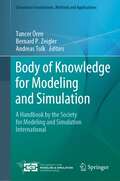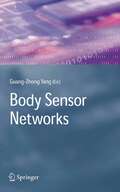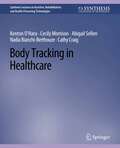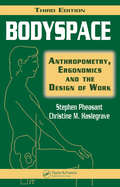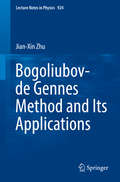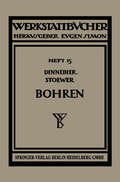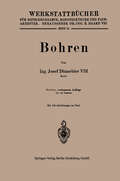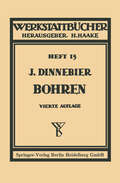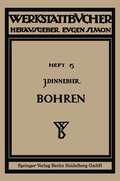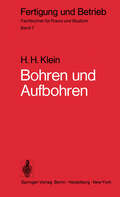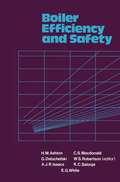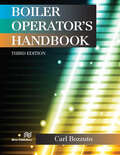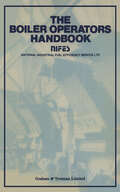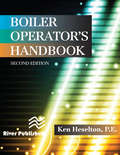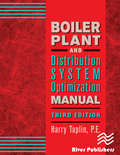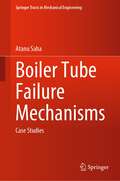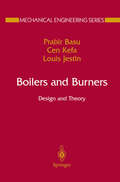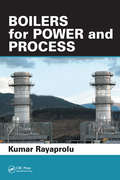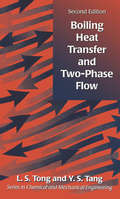- Table View
- List View
Body of Knowledge for Modeling and Simulation: A Handbook by the Society for Modeling and Simulation International (Simulation Foundations, Methods and Applications)
by Tuncer Ören Bernard P. Zeigler Andreas TolkCommissioned by the Society for Modeling and Simulation International (SCS), this needed, useful new ‘Body of Knowledge’ (BoK) collects and organizes the common understanding of a wide collection of professionals and professional associations.Modeling and simulation (M&S) is a ubiquitous discipline that lays the computational foundation for real and virtual experimentation, clearly stating boundaries—and interactions—of systems, data, and representations. The field is well known, too, for its training support via simulations and simulators. Indeed, with computers increasingly influencing the activities of today’s world, M&S is the third pillar of scientific understanding, taking its place along with theory building and empirical observation.This valuable new handbook provides intellectual support for all disciplines in analysis, design and optimization. It contributes increasingly to the growing number of computational disciplines, addressing the broad variety of contributing as well as supported disciplines and application domains. Further, each of its sections provide numerous references for further information. Highly comprehensive, the BoK represents many viewpoints and facets, captured under such topics as:Mathematical and Systems Theory FoundationsSimulation Formalisms and ParadigmsSynergies with Systems Engineering and Artificial IntelligenceMultidisciplinary ChallengesEthics and PhilosophyHistorical PerspectivesExamining theoretical as well as practical challenges, this unique volume addresses the many facets of M&S for scholars, students, and practitioners. As such, it affords readers from all science, engineering, and arts disciplines a comprehensive and concise representation of concepts, terms, and activities needed to explain the M&S discipline.Tuncer Ören is Professor Emeritus at the University of Ottawa. Bernard Zeigler is Professor Emeritus at the University of Arizona. Andreas Tolk is Chief Scientist at The MITRE Corporation. All three editors are long-time members and Fellows of the Society for Modeling and Simulation International. Under the leadership of three SCS Fellows, Dr. Ören, University of Ottawa, Dr. Zeigler, The University of Arizona, and Dr. Tolk, The MITRE Corporation, more than 50 international scholars from 15 countries provided insights and experience to compile this initial M&S Body of Knowledge.
Body Sensor Networking, Design and Algorithms
by Saeid Sanei Delaram Jarchi Anthony G. ConstantinidesA complete guide to the state of the art theoretical and manufacturing developments of body sensor network, design, and algorithms In Body Sensor Networking, Design, and Algorithms, professionals in the field of Biomedical Engineering and e-health get an in-depth look at advancements, changes, and developments. When it comes to advances in the industry, the text looks at cooperative networks, noninvasive and implantable sensor microelectronics, wireless sensor networks, platforms, and optimization—to name a few. Each chapter provides essential information needed to understand the current landscape of technology and mechanical developments. It covers subjects including Physiological Sensors, Sleep Stage Classification, Contactless Monitoring, and much more. Among the many topics covered, the text also includes additions such as: ● Over 120 figures, charts, and tables to assist with the understanding of complex topics ● Design examples and detailed experimental works ● A companion website featuring MATLAB and selected data sets Additionally, readers will learn about wearable and implantable devices, invasive and noninvasive monitoring, biocompatibility, and the tools and platforms for long-term, low-power deployment of wireless communications. It’s an essential resource for understanding the applications and practical implementation of BSN when it comes to elderly care, how to manage patients with chronic illnesses and diseases, and use cases for rehabilitation.
Body Sensor Networking, Design and Algorithms
by Saeid Sanei Delaram Jarchi Anthony G. ConstantinidesA complete guide to the state of the art theoretical and manufacturing developments of body sensor network, design, and algorithms In Body Sensor Networking, Design, and Algorithms, professionals in the field of Biomedical Engineering and e-health get an in-depth look at advancements, changes, and developments. When it comes to advances in the industry, the text looks at cooperative networks, noninvasive and implantable sensor microelectronics, wireless sensor networks, platforms, and optimization—to name a few. Each chapter provides essential information needed to understand the current landscape of technology and mechanical developments. It covers subjects including Physiological Sensors, Sleep Stage Classification, Contactless Monitoring, and much more. Among the many topics covered, the text also includes additions such as: ● Over 120 figures, charts, and tables to assist with the understanding of complex topics ● Design examples and detailed experimental works ● A companion website featuring MATLAB and selected data sets Additionally, readers will learn about wearable and implantable devices, invasive and noninvasive monitoring, biocompatibility, and the tools and platforms for long-term, low-power deployment of wireless communications. It’s an essential resource for understanding the applications and practical implementation of BSN when it comes to elderly care, how to manage patients with chronic illnesses and diseases, and use cases for rehabilitation.
Body Sensor Networks
by M. Yacoub Guang-Zhong YangThis book addresses the issues of the rapidly changing field of wireless wearable and implantable sensors. It also discusses the latest technological developments and clinical applications of body-sensor networks (BSN). BSN is a new area of research and the last decade has seen a rapid surge of interest. The book also provides a review of current wireless sensor development platforms and a guide to developing your own BSN applications.
Body Sensors and Electrocardiography (SpringerBriefs in Applied Sciences and Technology)
by Roman Trobec Ivan Tomašić Aleksandra Rashkovska Matjaž Depolli Viktor AvbeljThis monograph presents a comprehensive overview of the electrocardiography from the aspect of wireless and mobile monitoring and its potential for personalized health management. The topical focus is on the implementation and efficient application of user friendly m-Health systems. The target audience comprises biomedical engineers, medical doctors, students, industrial experts and health managers developing m-Health solutions.
Body Tracking in Healthcare (Synthesis Lectures on Assistive, Rehabilitative, and Health-Preserving Technologies)
by Kenton O'Hara Cecily Morrison Abigail Sellen Nadia Bianchi-Berthouze Cathy CraigWithin the context of healthcare, there has been a long-standing interest in understanding the posture and movement of the human body. Gait analysis work over the years has looked to articulate the patterns and parameters of this movement both for a normal healthy body and in a range of movement-based disorders. In recent years, these efforts to understand the moving body have been transformed by significant advances in sensing technologies and computational analysis techniques all offering new ways for the moving body to be tracked, measured, and interpreted. While much of this work has been largely research focused, as the field matures, we are seeing more shifts into clinical practice. As a consequence, there is an increasing need to understand these sensing technologies over and above the specific capabilities to track, measure, and infer patterns of movement in themselves. Rather, there is an imperative to understand how the material form of these technologies enables them also to be situated in everyday healthcare contexts and practices. There are significant mutually interdependent ties between the fundamental characteristics and assumptions of these technologies and the configurations of everyday collaborative practices that are possible them. Our attention then must look to social, clinical, and technical relations pertaining to these various body technologies that may play out in particular ways across a range of different healthcare contexts and stakeholders. Our aim in this book is to explore these issues with key examples illustrating how social contexts of use relate to the properties and assumptions bound up in particular choices of body-tracking technology. We do this through a focus on three core application areas in healthcare—assessment, rehabilitation, and surgical interaction—and recent efforts to apply body-tracking technologies to them.
Bodyspace: Anthropometry, Ergonomics and the Design of Work, Third Edition
by Stephen Pheasant Christine M. HaslegraveIn the 20 years since the publication of the first edition of Bodyspace the knowledge base upon which ergonomics rests has increased significantly. The need for an authoritative, contemporary and, above all, usable reference is therefore great. This third edition maintains the same content and structure as previous editions, but updates the material and references to reflect recent developments in the field. The book has been substantially revised to include new research and anthropometric surveys, the latest techniques, and changes in legislation that have taken place in recent years. New coverage in the third edition: Guidance on design strategies and practical advice on conducting trials Overview of recent advances in simulation and digital human modes Dynamic seating · Recent work on hand/handle interface Computer input devices · Laptop computer use and children’s use of computers · Design for an aging population and accessibility for people with disabilities · New approaches to risk management and new assessment tools, legislation, and standards As the previous two editions have shown, Bodyspace is an example of the unusual: a text that is a favorite among academics and practitioners. Losing none of the features that made previous editions so popular, the author skillfully integrates new knowledge into the existing text without sacrificing the easily accessible style that makes this book unique. More than just a reference text, this authoritative book clearly delineates the field of ergonomics.
Bodyspace: Anthropometry, Ergonomics and the Design of Work, Third Edition
by Stephen Pheasant Christine M. HaslegraveIn the 20 years since the publication of the first edition of Bodyspace the knowledge base upon which ergonomics rests has increased significantly. The need for an authoritative, contemporary and, above all, usable reference is therefore great. This third edition maintains the same content and structure as previous editions, but updates the material and references to reflect recent developments in the field. The book has been substantially revised to include new research and anthropometric surveys, the latest techniques, and changes in legislation that have taken place in recent years. New coverage in the third edition: Guidance on design strategies and practical advice on conducting trials Overview of recent advances in simulation and digital human modes Dynamic seating · Recent work on hand/handle interface Computer input devices · Laptop computer use and children’s use of computers · Design for an aging population and accessibility for people with disabilities · New approaches to risk management and new assessment tools, legislation, and standards As the previous two editions have shown, Bodyspace is an example of the unusual: a text that is a favorite among academics and practitioners. Losing none of the features that made previous editions so popular, the author skillfully integrates new knowledge into the existing text without sacrificing the easily accessible style that makes this book unique. More than just a reference text, this authoritative book clearly delineates the field of ergonomics.
Bogoliubov-de Gennes Method and Its Applications (Lecture Notes in Physics #924)
by Jian-Xin ZhuThe purpose of this book is to provide an elementary yet systematic description of the Bogoliubov-de Gennes (BdG) equations, their unique symmetry properties and their relation to Green’s function theory. Specifically, it introduces readers to the supercell technique for the solutions of the BdG equations, as well as other related techniques for more rapidly solving the equations in practical applications.The BdG equations are derived from a microscopic model Hamiltonian with an effective pairing interaction and fully capture the local electronic structure through self-consistent solutions via exact diagonalization. This approach has been successfully generalized to study many aspects of conventional and unconventional superconductors with inhomogeneities – including defects, disorder or the presence of a magnetic field – and becomes an even more attractive choice when the first-principles information of a typical superconductor is incorporated via the construction of a low-energy tight-binding model. Further, the lattice BdG approach is essential when theoretical results for local electronic states around such defects are compared with the scanning tunneling microscopy measurements.Altogether, these lectures provide a timely primer for graduate students and non-specialist researchers, while also offering a useful reference guide for experts in the field.
Bohren (Werkstattbücher #15)
by J. Dinnebier H. J. StoewerDieser Buchtitel ist Teil des Digitalisierungsprojekts Springer Book Archives mit Publikationen, die seit den Anfängen des Verlags von 1842 erschienen sind. Der Verlag stellt mit diesem Archiv Quellen für die historische wie auch die disziplingeschichtliche Forschung zur Verfügung, die jeweils im historischen Kontext betrachtet werden müssen. Dieser Titel erschien in der Zeit vor 1945 und wird daher in seiner zeittypischen politisch-ideologischen Ausrichtung vom Verlag nicht beworben.
Bohren (Werkstattbücher #15 )
by Josef DinnebierDieser Buchtitel ist Teil des Digitalisierungsprojekts Springer Book Archives mit Publikationen, die seit den Anfängen des Verlags von 1842 erschienen sind. Der Verlag stellt mit diesem Archiv Quellen für die historische wie auch die disziplingeschichtliche Forschung zur Verfügung, die jeweils im historischen Kontext betrachtet werden müssen. Dieser Titel erschien in der Zeit vor 1945 und wird daher in seiner zeittypischen politisch-ideologischen Ausrichtung vom Verlag nicht beworben.
Bohren (Werkstattbücher #15 )
by Josef DinnebierDieser Buchtitel ist Teil des Digitalisierungsprojekts Springer Book Archives mit Publikationen, die seit den Anfängen des Verlags von 1842 erschienen sind. Der Verlag stellt mit diesem Archiv Quellen für die historische wie auch die disziplingeschichtliche Forschung zur Verfügung, die jeweils im historischen Kontext betrachtet werden müssen. Dieser Titel erschien in der Zeit vor 1945 und wird daher in seiner zeittypischen politisch-ideologischen Ausrichtung vom Verlag nicht beworben.
Bohren und Aufbohren: Verfahren, Betriebsmittel, Wirtschaftlichkeit, Arbeitszeitermittlung (Fertigung und Betrieb #7)
by H.H. KleinBoiler Efficiency and Safety: A Guide for Managers, Engineers and Operators responsible for Small Steam Boilers
by W. L. RobertsonBoiler Operator's Handbook
by Carl BuzzutoWith the increased interest in climate impacts, sustainability, and efficiency, more responsibility is being placed on boiler operators to help improve performance and reduce emissions. This third edition of the Boiler Operator’s Handbook is intended to help such operators in the quest for improved operability and performance of their boilers and their plants. The theme of this book is to "operate wisely". The goal is to instill not only "know how" but "know why". The main details have been provided by the original author, Mr. Ken Heselton. This updated version has been somewhat expanded to include a wider range of examples and some of the more recent environmental requirements. To illustrate these points, topics include multi boiler operations, understanding the plant load, maintenance issues, and controls. Every plant is different. However, it is hoped that with the information provided in this book, the wise operator will be able to address the various unique issues posed by the specific plant and provide timely solutions to meet the present-day requirements.
Boiler Operator's Handbook
by Carl BuzzutoWith the increased interest in climate impacts, sustainability, and efficiency, more responsibility is being placed on boiler operators to help improve performance and reduce emissions. This third edition of the Boiler Operator’s Handbook is intended to help such operators in the quest for improved operability and performance of their boilers and their plants. The theme of this book is to "operate wisely". The goal is to instill not only "know how" but "know why". The main details have been provided by the original author, Mr. Ken Heselton. This updated version has been somewhat expanded to include a wider range of examples and some of the more recent environmental requirements. To illustrate these points, topics include multi boiler operations, understanding the plant load, maintenance issues, and controls. Every plant is different. However, it is hoped that with the information provided in this book, the wise operator will be able to address the various unique issues posed by the specific plant and provide timely solutions to meet the present-day requirements.
Boiler Operators Handbook
by Nifes Nifes LtdThe popularity of the Boiler Operators Handbook has prompted the issue of a revised edition. Other than a relatively small number of developments, essentially associated with solid fuel firing methods using the fluidised bed technique, no radical changes have occurred since the first edition of the Handbook was issued in 1969. In revising a work of this kind there is a great temptation to omit practices that are now less common in the UK. In view of the enormous pressure on Global energy resources, however, the chapters dealing in methods of hand-firing have been retained in the hope that they may be of value to those in the less developed nations where energy problems are infinitely greater than ours. High combustion intensity boilers, commonly known as Package Boilers, of the Shell Construction design, have now much greater steam output than their predecessors and the need for high levels of maintenance and operating skills remain as essential as when this group of boilers first appeared on the market. Also the standard of water treatment required is probably higher than the Operator has been accustomed to. The Health and Safety at Work Act re-emphasised the continued need for adherence to the principles that ensure a pressure vessel be maintained in a safe condition at all times. Accordingly the revised edition of the Boiler Operators Handbook has enlarged its sections on Safety and the Clean Air Act.
Boiler Operator's Handbook, Second Edition
by P. E. HeseltonThis book was written specifically for boiler plan operators and supervisors who want to learn how to lower plant operating costs, as well as how to operate plants of all types and sizes more wisely. It is newly revised with guidelines for HRSGs, combined cycle systems, and environmental effects of boiler operation. Also included is a new chapter on refrigeration systems that addresses the environmental effects of inadvertent and intentional discharges of refrigerants. Going beyond the basics of "keeping the pressure up," the author explains in clear terms how to set effective priorities to ensure optimal plant operation, including ensuring safety and continuity of operations, preventing damage, managing environmental impact, training replacement plant operators, logging and preserving historical data, and operating the plant economically.
Boiler Plant and Distribution System Optimization Manual, Third Edition
by Harry TaplinThe book has been upgraded with ten new checklists with over 100 ways to improve performance with 50 additional illustrations to communicate specific information about applying these technologies. The new checklists serve as a handy reference for designing an energy plan for your plants. Understanding that funds for energy come directly from your bottom line, this book has been designed for those tasked with increasing profits by reducing fuel costs while also reducing pollution and carbon footprints with attention to plant safety. The author presents many complex boiler-related topics in a simple and understandable way to simplify the decision-making process.
Boiler Tube Failure Mechanisms: Case Studies (Springer Tracts in Mechanical Engineering)
by Atanu SahaThis book presents failure mechanisms of different boiler components and preventive measures. It illustrates the basic steam flow and circuit design of steam boiler, boiler design parameters, boiler components materials and their behavior at different temperatures. The book aims to identify the cause(s) of in-service failure of secondary superheater tube, platen superheater tube and furnace water wall tube and also presents the solutions to avoid the future failures. This volume will be of interest to researchers and professionals working in the areas of energy, power generation, electric power plants, thermodynamics, industrial chemistry, etc.
Boilers and Burners: Design and Theory (Mechanical Engineering Series)
by Prabir Basu Cen Kefa Louis JestinA joint effort of three continents, this book is about rational utilization of the fossil fuels for generation of heat or power. It provides a synthesis of two scientific traditions: the high-performance, but often proprietary, Western designs, and the elaborate national standards based on less advanced Eastern designs; it presents both in the same Western format. It is intended for engineers and advanced undergraduate and graduate students with an interest in steam power plants, burners, or furnaces. The text uses a format of practice based on theory: each chapter begins with an explanation of a process, with basic theory developed from first principles; then empirical relationships are presented and, finally, design methods are explained by worked out examples. It will thus provide researchers with a resource for applications of theory to practice. Plant operators will find solutions to and explanations of many of their daily operational problems. Designers will find this book ready with required data, design methods and equations. Finally, consultants will find it very useful for design evaluation.
Boilers for Power and Process
by Kumar RayaproluBoiler professionals require a strong command of both the theoretical and practical facets of water tube-boiler technology. From state-of-the-art boiler construction to mechanics of firing techniques, Boilers for Power and Process augments seasoned engineers' already-solid grasp of boiler fundamentals. A practical explanation of theory, it d
Boiling Heat Transfer And Two-Phase Flow
by L S TongCompletely updated, this graduate text describes the current state of boiling heat transfer and two-phase flow, in terms through which students can attain a consistent understanding. Prediction of real or potential boiling heat transfer behaviour, both in steady and transient states, is covered to aid engineering design of reliable and effective systems.
Boiling Heat Transfer And Two-Phase Flow
by L S TongCompletely updated, this graduate text describes the current state of boiling heat transfer and two-phase flow, in terms through which students can attain a consistent understanding. Prediction of real or potential boiling heat transfer behaviour, both in steady and transient states, is covered to aid engineering design of reliable and effective systems.
